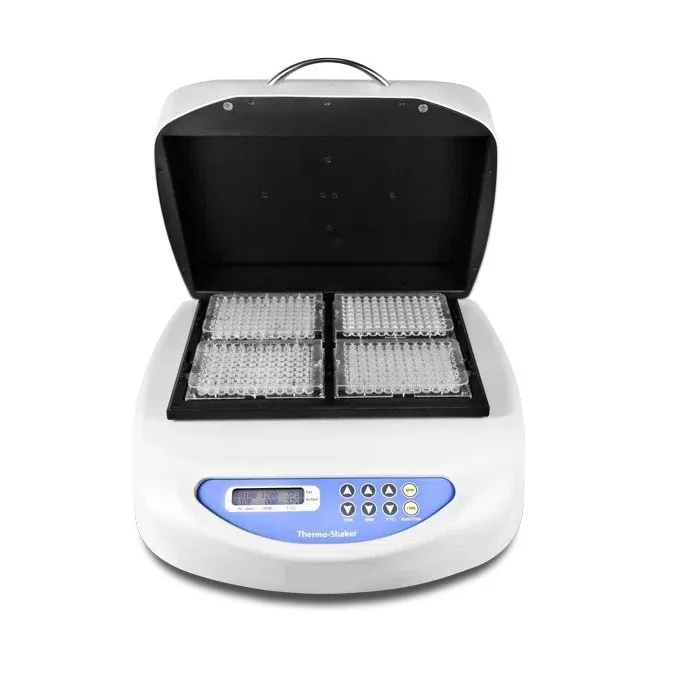Plate Shaker: Optimal Mixing for Microplates with Precision and Efficiency
A Plate Shaker KPS/4/60 is a specialized laboratory instrument designed to mix microplates with uniform shaking motion, ensuring that all wells receive consistent agitation. Essential for applications such as ELISA assays, cell culture, DNA/RNA purification, and biochemical reactions, plate shakers enhance workflow efficiency and result accuracy. Whether you’re working in biotechnology, pharmaceuticals, or clinical research, a plate shaker ensures the thorough mixing needed for precise experimental results.
What is a Plate Shaker?
A Plate Shaker is designed to shake multi-well plates such as 96-well and 384-well microplates at controlled speeds, delivering consistent mixing across all wells. The precise shaking action ensures that reagents, cells, or samples are evenly distributed, critical for reproducibility in assays and experiments. These devices are compact, easy to operate, and essential for laboratories requiring high throughput.
Key Features of a Plate Shaker
- Variable Speed Control: Plate shakers offer adjustable speed settings, ranging from gentle mixing to vigorous shaking, ensuring optimal results across various applications.
- Digital Display: Equipped with digital interfaces for easy programming of speed, time, and shaking intensity, plate shakers provide precise control over the process.
- Multi-Plate Compatibility: Designed to accommodate various microplate formats including 96-well, 384-well, and 1536-well plates, allowing flexibility for different laboratory protocols.
- Compact Footprint: Plate shakers are space-saving and compact, fitting easily into any lab environment without taking up excessive bench space.
- Orbital and Linear Shaking Motion: Some models offer both orbital (circular) and linear (back-and-forth) motion options, depending on the specific requirements of your experiment.
- Programmable Timer: Many models feature integrated timers that allow users to set specific run times for unattended operation, improving lab efficiency.
- Anti-Slip Design: Most plate shakers come with anti-slip platforms to keep plates securely in place, even during vigorous shaking, ensuring no spills or cross-contamination.
- Quiet Operation: Modern plate shakers are designed to operate quietly, reducing noise pollution in busy labs while maintaining high performance.
Applications of Plate Shakers
Plate shakers are used in various research and testing environments to ensure uniform mixing across wells, making them indispensable in:
- ELISA Assays: Plate shakers provide the consistent agitation required for enzyme-linked immunosorbent assays (ELISA), ensuring even reagent distribution for accurate results.
- Cell Culturing: They support cell culture applications by providing uniform movement, which helps in improving cell growth and preventing cell clumping.
- DNA/RNA Extraction: Plate shakers enhance the efficiency of nucleic acid extraction protocols by thoroughly mixing samples and reagents to promote better interaction and binding.
- Protein Purification: In protein assays, plate shakers ensure that reagents and proteins are properly mixed to yield reproducible and reliable results.
- Pharmaceutical Research: Plate shakers assist in the high-throughput screening of drug compounds by ensuring uniform mixing across all wells.
- Food and Beverage Testing: In food safety labs, plate shakers are used for microbial growth studies and enzyme-linked assays to ensure product safety and quality control.
Benefits of Using a Plate Shaker
- Precision Mixing: Plate shakers provide consistent and even agitation for each well in a microplate, eliminating the risk of experimental variations due to poor mixing.
- Increased Efficiency: With the ability to handle multiple microplates simultaneously, plate shakers reduce the time needed for manual mixing, significantly speeding up workflows.
- Versatility: Plate shakers can be used in a variety of applications, from cell culture to biochemical assays, making them a multi-purpose tool in any laboratory.
- Improved Accuracy: By providing consistent mixing, plate shakers help reduce human error, ensuring that all wells receive the same treatment and improving the reproducibility of results.
- Space-Efficient Design: Their compact size makes plate shakers a perfect fit for crowded lab benches, without sacrificing performance.
- User-Friendly Operation: With simple controls and programmable features, plate shakers are easy to use, allowing for automated and consistent operation.
How to Choose the Right Plate Shaker
When selecting a Plate Shaker for your lab, consider the following factors:
- Shaking Motion: Choose between orbital or linear motion based on your application. Orbital shaking is ideal for mixing fluids, while linear motion is better for suspending cells or particles.
- Speed Range: Ensure the plate shaker offers a wide speed range suitable for your specific tasks, from gentle agitation to more vigorous shaking.
- Plate Capacity: Depending on your lab’s throughput, select a model that can hold multiple plates simultaneously, increasing your productivity.
- Control Options: A digital control panel with programmable settings for time and speed will give you better control over the shaking process.
- Compatibility: Make sure the plate shaker is compatible with the types of microplates you use most frequently, such as 96-well or 384-well plates.
- Safety Features: Look for plate shakers with anti-slip surfaces or lock-in features to prevent plates from shifting during shaking.
Industries Benefiting from Plate Shakers
Plate shakers are widely used in industries where precision and efficiency are critical:
- Biotechnology: Used in nucleic acid extraction, cell culture, and protein purification.
- Pharmaceuticals: Essential for high-throughput screening of compounds, drug discovery, and biochemical assays.
- Clinical Diagnostics: Used for ELISA testing, serological assays, and other diagnostic tests.
- Food and Beverage: Helps in microbial growth studies and enzyme-linked assays for food safety and quality control.
- Environmental Testing: Used in labs for water and soil analysis to ensure proper mixing of samples.
Conclusion
A Plate Shaker is an essential instrument for any lab involved in high-throughput testing, cell culture, or biochemical assays. With precise control over shaking speed and motion, these devices ensure consistent results across all wells, reducing the risk of error and increasing lab efficiency. Whether you’re working in pharmaceuticals, biotechnology, or diagnostics, investing in a reliable plate shaker will help you streamline your workflow and improve your experimental outcomes.





Reviews
There are no reviews yet.